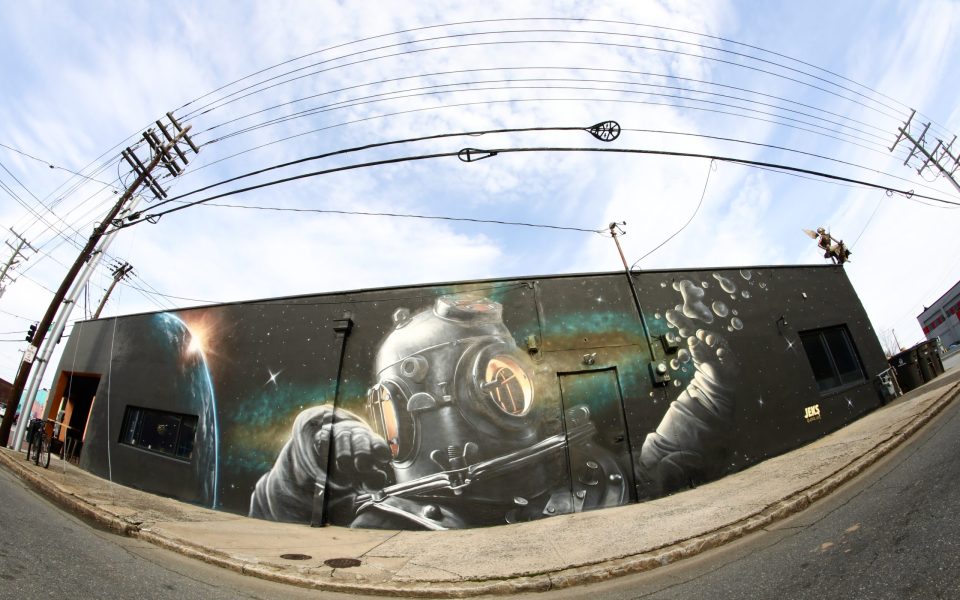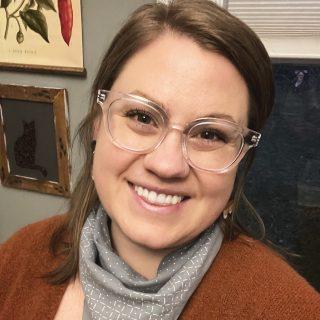Featured photo: The mural by Brian Lewis, Jeks, on the side of the Hoots Satellite building is facing an uncertain future. (photo by Jerry Cooper)
It’s a scene that frequent visitors of Winston-Salem’s various social media pages have seen time and time again. A post will report: City council approves parkway dandelion sculptures; Monstercade reaches out to Bartsy in an attempt to commission art; The artist JEKS pays homage to deceased Winston-Salem rapper, SauxePaxk TB with a photorealistic portrait mural. Each story and project are then met with a dissonance of comments that range from skepticism to blatant confusion: “We’re the city of Arts and Innovation – where’s the art?”
The WSNC Mural Project is here to answer that question.
The Mural Project began in 2021 when John Armbruster, Vikki Vassar and Mark Lamb noticed that Winston-Salem was lacking a comprehensive list of public art, despite the moniker, “City of Arts and Innovation.”
Vassar describes the earliest stages of the project.
“I wanted to start aggregating data, having a resource that people could point to,” she says. “We started traveling through the city and when we saw something, we’d note the location and take a photo.”

With over 105 data points, the collection includes murals, sculptures, graffiti, ghost advertising and even previous murals that have since been repurposed. The intentions of this project are both art exposure and preservation.
“There was this group of girls in the early 2000s, the Renegade Ninja Cowgirls, running around downtown doing guerilla art, when there was nothing here,” Vassar explains. “But other than a News & Record article, there’s no publicly available records of this.”
The impermanence of public art, especially in cases like the Renegade Ninja Cowgirls, gives allowance for topical work. Their “positive-propaganda,” took place directly after the events of 9/11.
That same volatility leaves room for erasure over time.
“Through the project, we’re trying to lend some permanence to what is, by nature, an impermanent thing. The art could be signage, advertising, anything,” Lamb says. “The purpose of a building may change through the years. A new owner or tenant may look at that art and say, ‘This doesn’t fit my needs; we need to do something different.’”
A prime example is the unknown future of the Hoots Satellite mural, a JEKS painting, commissioned by Hoots Beer Company of a scuba diver, wearing a nautical vintage diving helmet, floating through space. The building at 701 Trade Street, previously Elliot’s Revue, Luna Lounge and Test Pattern, most recently housed Hoots’ satellite location, which closed last month. Eric Weyer, co-owner of Hoots, explains their inspiration for the piece.

“There was nothing there when we moved in, but when it was the bar Satellite back in the ’90s, there was a space-themed mural, so we wanted to continue with that,” he says.
The space-themed mural was a painting by Armand de Navarre with John Blackburn, commissioned by Damon Carmona in 1998. The mural depicts a silver dome-shaped ship opening its door for bubble-helmeted, mostly nude beings who float out against a royal blue backdrop of constellations and planets. The piece, which is now one of the beloved examples of public art in the city, set the foundation for art on Trade St. as the Art’s District’s first mural.
As far as the most recent mural’s fate, “I’m uncertain,” Weyer says.
“Without documentation and data, the discussion of preserving public art cannot happen,” says Armbruster. “We can use this data to prepare for discussions regarding art in the City of Arts and Innovation. It’s a resource that doesn’t seem to be available yet.”
Many of the current data points on the map were plotted by Armbruster himself, after driving through various neighborhoods of Winston-Salem.
One of the often overlooked neighborhood murals is the Historic East Winston Mural, a chronological depiction of varying accomplishments of Winston-Salem’s Black community. Painted on the side of Titanic Food Mart by Marianne Di Napoli-Mylet and Donnell Williams in 2015, the mural is a highlight of the often hidden-in-plain-site art the Mural Project hopes to illuminate. But to do so, the organizers are looking for community involvement.

“We need everyone’s assistance,” says Vassar. “You walk by something, let us know it’s there, whatever it is.”
She continues, “It’s community members that are really going to flesh out this project and bring it from 105 points to 350 points. If anyone has pictures of past murals and can tell us where they were, we would love to get that information. I don’t have a way to photograph something that existed 15 years ago.”
They each hope that involving the community will encourage conversation about the nature and definition of public art.
“The fact of the matter is, you can put something up there, and let the viewer decide whether or not they think it’s art,” Lamb explains.
The collaborative process is something the Mural Project depends on. Community members can submit recommendations of pieces they discover and consider public art through the contact section of the website.
Funding for the Mural Project currently comes directly from the sales of Vassar’s own artwork, @thatblondegirlvikki. She refers to the project as a labor of love.
“We need a broadly available public resource for the art in Winston-Salem” she says.“We want to make a walkable map where the art is concentrated, to eventually do a coffee table book. It’s an ongoing process, but we want to pay respect to the art here in Winston. There is so much of it that people miss.”
Learn more about the mural project at wsncmuralproject.com.
Join the First Amendment Society, a membership that goes directly to funding TCB‘s newsroom.
We believe that reporting can save the world.
The TCB First Amendment Society recognizes the vital role of a free, unfettered press with a bundling of local experiences designed to build community, and unique engagements with our newsroom that will help you understand, and shape, local journalism’s critical role in uplifting the people in our cities.
All revenue goes directly into the newsroom as reporters’ salaries and freelance commissions.


Leave a Reply